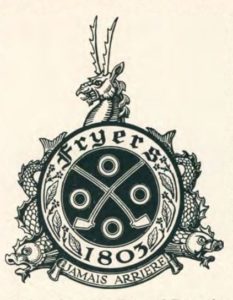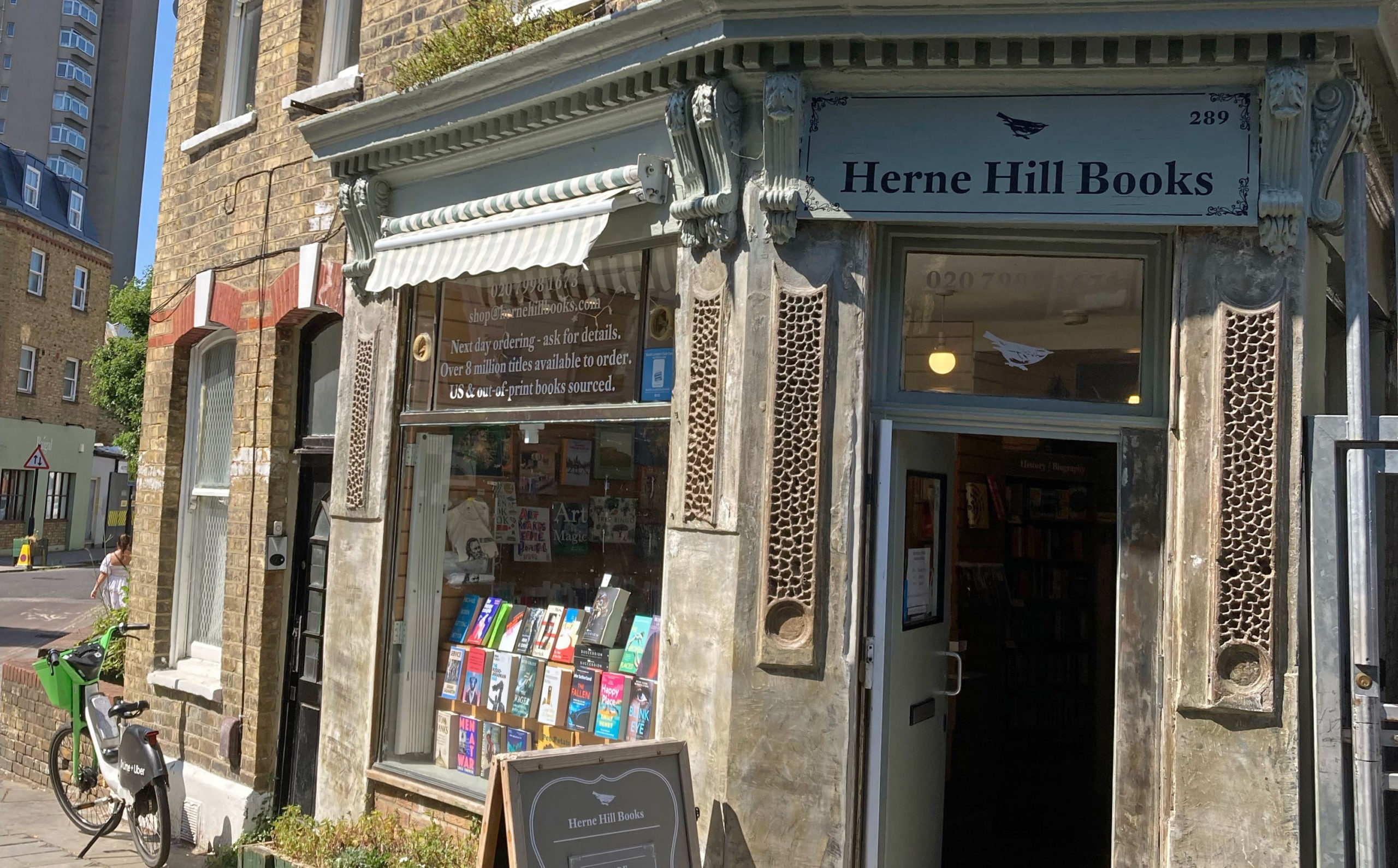This shop is currently home to Herne Hill Books.
Today, it is an independent bookshop… but over its lifetime this premises has served many purposes, and for many years was a tobacconist’s.
It was originally known as 25 Lett Street, but following street re-numbering in 1888 became 289 Railton Road. Lett Street comprised the stretch of Railton Road between the alley (once a public footpath, but now shut off) at the side of 25 and the last house in the terrace, where the road now bends and the LTN begins. Lett Street was named after a major local landowner, Thomas Lett, a prosperous timber merchant. The Lett family house was on land between Red Post Hill and Half Moon Lane (demolished c.1890).
The 1871 census only shows some of the houses on Lett Street, which suggests that they were not all occupied, possibly because not yet completed. The 1870 OS map shows no houses at all, though the road has been laid out.
The name of John William [Godier] Pilcher appears as a tobacconist in one 1880 Directory but not in another. He is also recorded in the 1881 census, aged 33, as resident at 25 Lett Street, but his occupation is given as “commercial clerk”. He is married to Eleanor, age 32, born in Sydney, New South Wales. They have four children aged between six years and eight months, the youngest two born in Herne Hill. So there must be some doubt as to whether John Pilcher was ever a tobacconist. By 1894 there is a different name for a tobacconist at what is now 289 Railton Road: Sidney H. King.

Fryer trademark
From 1897 the directories give the name Christopher Fryer.
Fryer was the owner of the shop, not the shopkeeper. Fryer was a tobacco manufacturer and came from a family with a long history in the business, some of which it has been possible to trace. They are representative of a 19th-century London that was a manufacturing city, with many manufacturers large and small. The Fryers’ factory was located in Smithfield.
An earlier Christopher Fryer appears as early as 9 July 1793 in the London Gazette in partnership as a tobacconist at Fox’s-lane Shadwell, and again in the Public Ledger & Daily Advertiser of 11 July 1805. But in 1830 there is a sale by order of the directors of the London Dock Company of all the plant, utensils etc. in the shop of Christopher Fryer, tobacconist, Foxes-lane Shadwell. The sale description shows that this was not a simple shop, but a factory where tobacco products were manufactured for onward sale. The London docks were the prime area for the importation of raw tobacco, especially from Virginia, a trade heavily dependent on slave labour. This introduces an additional dimension to the history of our shops, which include many tobacconists.
Remarkably, a copy of Pipe Lovers for September 1948, an American magazine “for men who enjoy a pipe” gives a history of the firm (but not necessarily accurate). It says it was started by William Fryer, and then passed to his son Christopher and then to Christopher’s son, Clare Fryer. The article includes an attractive trademark (with so-called “churchwardens pipes”) used by the firm that claims its founding in 1805. Adverts for Fryers tobacco in the 1920s also claims three generations of Fryers.
William Fryer, possibly a son of the Christopher Fryer at Foxes-lane Shadwell, can be found in 1846 as assignee of a bankrupt’s estate. He is a tobacco manufacturer of Smithfield-bars, one of the historic entrances to the City. William Fryer dies in 1861 (Morning Post 23 November) at his residence in Brixton. And a notice in the London Gazette of 24 June 1862 refers to his widow Annie Isabel Fryer and him being “late of York Cottage, Brixton”. However, it has not been possible to trace William Fryer in the census. His probate mentions a brother, Thomas Mitchell Fryer, Fleets House, East Witton, Yorkshire and widow Mary (sic) Fryer. A Yorkshire connection could explain “York Cottage”.
It does not seem that William Fryer had children, and the Christopher Fryer who develops the tobacco business in the later 19th century, together with John Henry Coultman, is not his son – possibly his nephew. His parents were Christopher and Harriet Fryer and his father was a wine merchant. This Christopher Fryer (born c.1837) can be traced in the 1871, 1881 and 1891 censuses and he has the eldest son Christopher St Clair Fryer born c.1869. He seems later to become Christopher Clare Fryer. The 1891 census shows him as clerk to his father’s business. The family lives at various addresses in the Hampstead/Willesden area. Christopher Fryer jr. marries Lilian Elsie Hall in the parish church of Tooting Graveney on 19 February 1898. He is described as a “manufacturer”, with his address as 139 Fellows Road, S. Hampstead, which links him directly to Christopher Fryer sr.
Strangely, in 1901 Christopher Fryer jr. is living at 16 Whippendell Road, Watford, as tobacco manufacturer, employer, with his wife Lilian, and two children, Phyllis (two) and Arthur C. [Clare] (six months), one general servant and a nursemaid. But this road in Watford is artisan/lower middle-class in its occupations. And in 1904 Christopher Clare Fryer dies, aged 35, at New Milton Hants, leaving just £46 10s. One wonders what lies behind this.
Meanwhile Christopher Fryer sr. has retired to Ryde on the Isle of Wight, to a road with distinctly grand houses. He dies in 1927 (in Haywards Heath) and leaves £15,340.
But there are two other sons and the firm continues, though judging from newspaper advertisements does not last long after World War II. Arthur Clare Fryer, the son of the Christopher who died in 1904, does not join the family business, but the Indian (Imperial) Police. He dies in 1940.
One of the most popular Fryer brands was their “Prince of Wales Smoking Mixture”. There was a legal dispute in 1913/14 when an association for holders of the Royal Warrant challenged (unsuccessfully) a Fryer trademark registered in 1876 that used the Prince of Wales feathers for their brand.
The Frederick Gorton shown as the shopkeeper/tobacconist in 1914 was born in 1870, probably at 155 St John Street, Clerkenwell, the very street where tobacco manufacturers Fryer & Sons (or probably at that date Fryer & Coultman) had their factory. His father, aged 33, was a butcher. Frederick was the youngest of four children. But his father must have died young, for in 1881 his mother, now widowed and a laundress, has moved with the family to Upper Holloway. His sister Florence is not shown, so possibly has also died, but he now has a younger sister Edith. By 1901 Frederick is married to Matilda (now aged 33, born Newington, South London), and they are living above the shop at 289 Railton Road. He is a “worker”, not on his own account, from which one can assume he is employed by Fryers. They have two children, Edith aged eight (born Camberwell), and Fred, two (born Lambeth).
The accommodation above the shop is also occupied in 1901 by a second family, headed by Emily Roberts age 56, born Westerham, a charwoman, and her two daughters, Rebecca, 22, and Emily, 19, the elder working for a tea dealer and grocery wholesaler and the younger on her own account as a dressmaker.
The Gorton family is still here in 1911. Edith is now a typist and shorthand clerk working for the “Anti-vaccination League”.
By 1921 the Gortons had moved to 30 Deronda Road, Herne Hill. Frederick Gorton died in Carshalton aged 81 in 1950, leaving £8,600. His wife Matilda had died in 1936.
The Directories for 1917 and 1921 have the name A.I. Drapkin (1917 has “Rapkin” in error) for the shopkeeper. Abraham Isaac Drapkin, born 1860, was a Russian Jewish immigrant, shown in his Naturalisation document of 18 June 1888 as aged 28 and a Cigar and Tobacco Manufacturer, married and with two children, Rebecca and Alice, aged three and one respectively. In 1891 he was living in Stamford Hill (Hackney), now with three daughters. His wife Rosa, aged 24 in 1891, was also from Russia. She died in 1898. In 1911 the Drapkins are living at 33 Highbury Place, Islington. He had remarried in 1903, his wife is now Bertha, 34, born in Leeds. His three unmarried daughters and son Coleman Drapkin, aged 18, are all living at home. Abraham Drapkin was a successful businessman with a number of tobacconist shops in London. When he died in 1927 he left £102,817 (£5.7 million in today’s terms).
Drapkin’s name in the 1917 directory suggests that by this date he had acquired the business from Fryer & Sons.
By 1934 the shop was run by Joseph Robert H. Kidby. He was still there in 1956. By 1969 the tobacconist was F. Scott.
This article forms part of the “History of Shops” project, created and researched by the Herne Hill Society.

